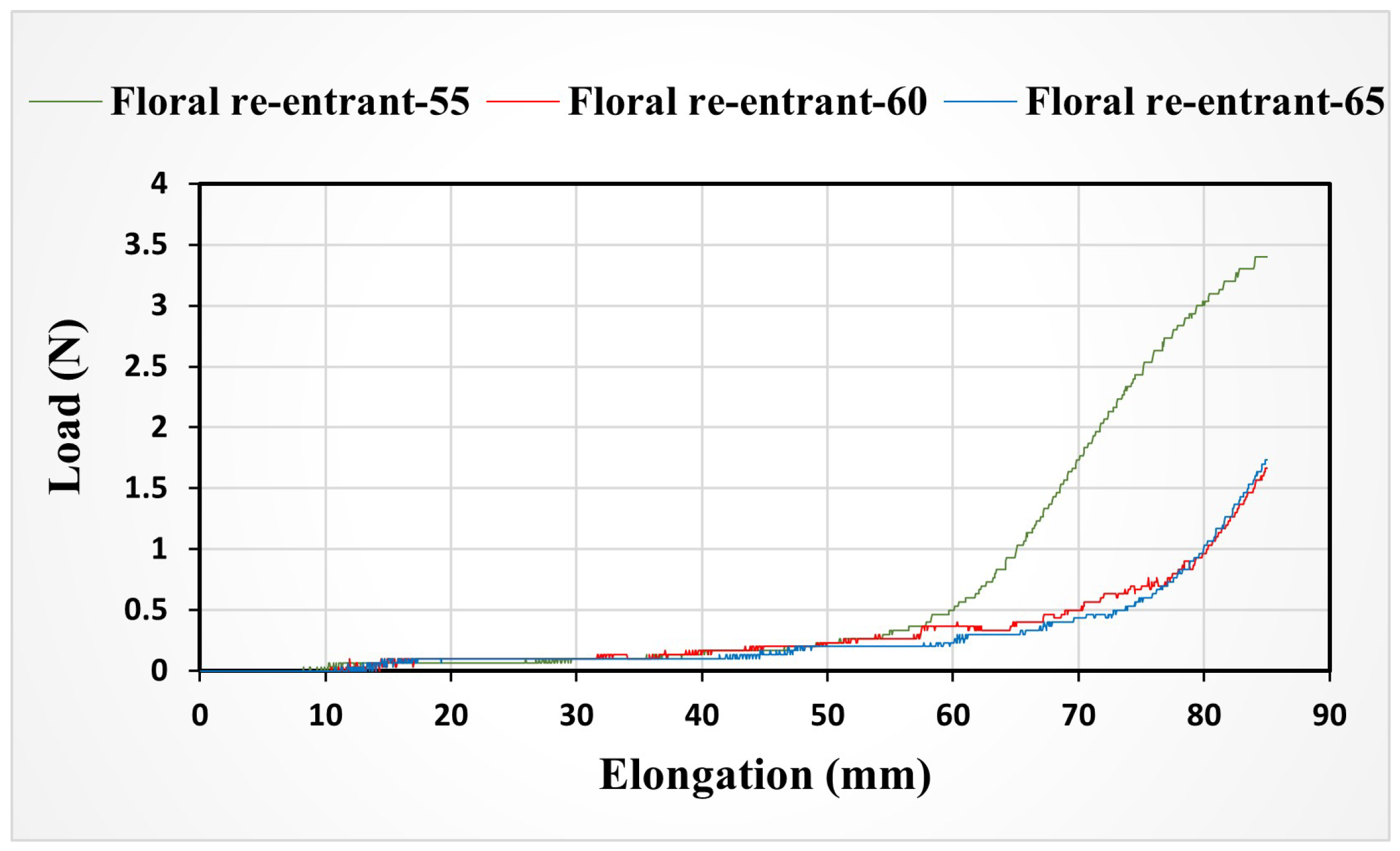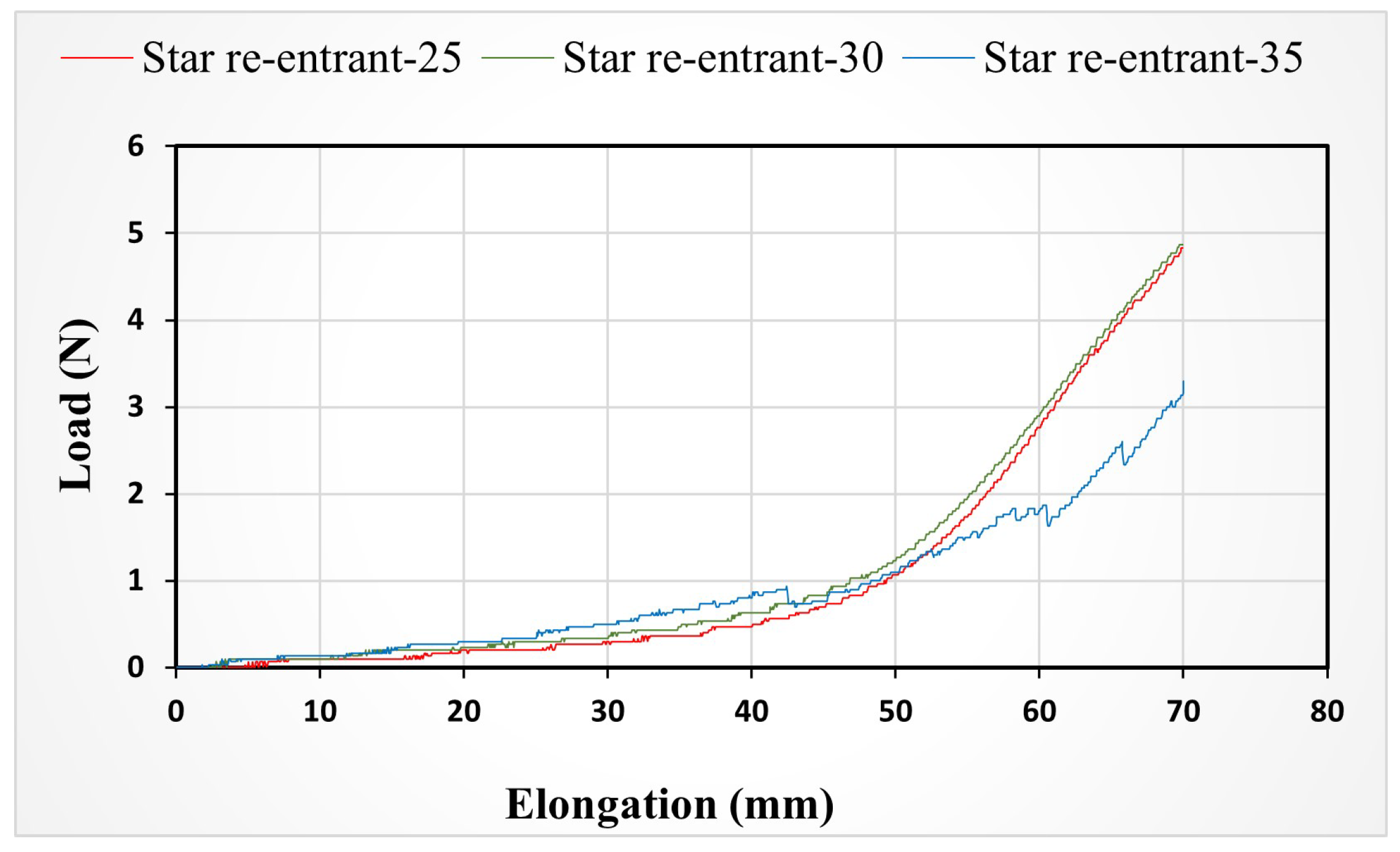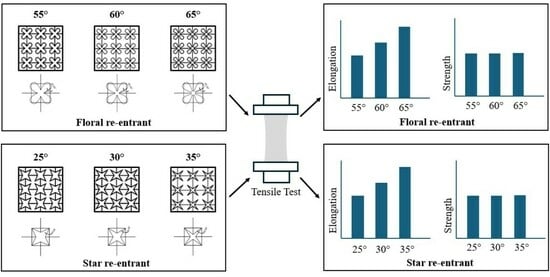The Effect of Orientation Angle of Center Facing Arm on Elongation of 3D-Printed Auxetic-Structure Textiles
Abstract
1. Introduction
2. Literature Review
2.1. Development of 3D-Printed Textiles
2.2. Auxetic Structure
2.3. Auxetic-Structure 3D-Printed Textiles
2.4. Elongation and Strength of 3D-Printed Auxetic-Structure Textiles
3. Materials and Methods
3.1. Textile Sample Development
3.2. Tensile Test
3.3. Data Analysis Procedures
4. Results and Discussion
4.1. The Effect of Orientation Angle on Elongation
4.2. The Effect of Orientation Angle on Strength
5. Conclusions
Author Contributions
Funding
Data Availability Statement
Conflicts of Interest
Abbreviations
| 3DP | 3D printing |
| FDM | Fused deposition modeling |
References
- Chakraborty, S.; Biswas, M.C. 3D printing technology of polymer-fiber composites in textile and fashion industry: A potential roadmap of concept to consumer. Compos. Struct. 2020, 248, 112562. [Google Scholar] [CrossRef]
- Lee, Y.A.; Koo, S.H. Introduction to special collection on 3D printing and wearable technology in fashion. Fash. Text. 2018, 5, 34. [Google Scholar] [CrossRef]
- Sheikh, J.A.; Waheed, M.F.; Khalid, A.M.; Qureshi, I.A. Use of 3D printing and nano materials in fashion: From revolution to evolution. In Advances in Design for Inclusion, 1st ed.; Bucchianico, G.D., Ed.; Springer: Cham, Switzerland, 2020; Volume 954, pp. 422–429. [Google Scholar]
- Anderson, I. Mechanical properties of specimens 3D printed with virgin and recycled polylactic acid. 3D Print. Addit. Manuf. 2017, 4, 110–115. [Google Scholar] [CrossRef]
- Voet, V.S.D.; Guit, J.; Loos, K. Sustainable photopolymers in 3D printing: A review on biobased, biodegradable, and recyclable alternatives. Macromol. Rapid Commun. 2021, 42, 2000475. [Google Scholar] [CrossRef]
- Peeters, B.; Kiratli, N.; Semeijn, J. A barrier analysis for distributed recycling of 3D printing waste: Taking the maker movement perspective. J. Clean. Prod. 2019, 241, 118313. [Google Scholar] [CrossRef]
- Santander, P.; Sanchez, F.A.C.; Boudaoud, H.; Camargo, M. Closed loop supply chain network for local and distributed plastic recycling for 3D printing: A MILP-based optimization approach. Resour. Conserv. Recycl. 2020, 154, 104531. [Google Scholar] [CrossRef]
- Wu, M.; Zhi, C.; Tu, L.; Wang, Y.; Dai, Y.; Yu, L.; Meng, J.; He, X. Cotton-containing printing wires based on the two-dimensional braiding method for three-dimensional printing of clothing. Text. Res. J. 2022, 92, 1384–1393. [Google Scholar] [CrossRef]
- Lee, S.K.; Koo, S. Development of three-dimensional printed cultural fashion products using symbols of longevity. Text. Res. J. 2022, 92, 4484–4500. [Google Scholar] [CrossRef]
- Sitotaw, D.B.; Ahrendt, D.; Kyosev, Y.; Kabish, A.K. Additive manufacturing and textiles—State-of-the-art. Appl. Sci. 2020, 10, 5033. [Google Scholar] [CrossRef]
- Lee, Y.A.; Li, Y. Bouncing with 3D Printed Soft Cells. In Proceedings of the International Textile and Apparel Association Annual Conference, Denver, CO, USA, 26–29 October 2022. [Google Scholar]
- Beecroft, M. Digital interlooping: 3D printing of weft-knitted textile-based tubular structures using selective laser sintering of nylon powder. Int. J. Fash. Des. Technol. Educ. 2019, 12, 218–224. [Google Scholar] [CrossRef]
- Chatterjee, K.; Ghosh, T.K. 3D printing of textiles: Potential roadmap to printing with fibers. Adv. Mater. 2020, 32, 1902086. [Google Scholar] [CrossRef] [PubMed]
- Tadesse, M.G.; Loghin, C.; Dulgheriu, I.; Loghin, E. Comfort evaluation of wearable functional textiles. Materials 2021, 14, 6466. [Google Scholar] [CrossRef] [PubMed]
- Williams, J.T. Textiles for Cold Weather Apparel, 1st ed.; Woodhead Publishing: New Delhi, India, 2009. [Google Scholar]
- Varghese, N.; Thilagavathi, G. Development of woven stretch fabrics and analysis on handle, stretch, and pressure comfort. J. Text. Inst. 2014, 106, 242–252. [Google Scholar] [CrossRef]
- Shaw, V.P.; Mukhopadhyay, A. Behaviour of stretch denim fabric under tensile load. Fibers Polym. 2022, 23, 295–302. [Google Scholar] [CrossRef]
- Elmogahzy, Y.; Farag, R. Tensile properties of cotton fibers: Importance, research, and limitations. In Handbook of Tensile Properties of Textiles and Technical Fibres, 2nd ed.; Bunsell, A.R., Ed.; Woodhead Publishing: New Delhi, India, 2018; pp. 223–273. [Google Scholar]
- Delhom, C.D.; Wanjura, J.D.; Hequet, E.F. Cotton fibre elongation: A review. J. Text. Inst. 2024, 115, 159–170. [Google Scholar] [CrossRef]
- Xiao, Y.Q.; Kan, C.W. Review on development and application of 3D-printing technology in textile and fashion design. Coatings 2022, 12, 267. [Google Scholar] [CrossRef]
- Kabir, S.; Li, Y.; Salahuddin, M.; Lee, Y.A. Drapability of 3D-printed auxetic structure textiles for wearable products through the digital image processing technique. Cloth. Text. Res. J. 2023, 43, 48–64. [Google Scholar] [CrossRef]
- Shajoo, S.; Schmelzeisen, D.; Pastore, C. Auxetic structures from 3D printed hybrid textiles. Commun. Dev. Assem. Text. Prod. 2021, 2, 91–102. [Google Scholar] [CrossRef]
- Spahiu, T.; Canaj, E.; Shehi, E. 3D printing for clothing production. J. Eng. Fibers Fabr. 2020, 15, 1–8. [Google Scholar] [CrossRef]
- Yang, C.; Vora, H.D.; Chang, Y. Behavior of auxetic structures under compression and impact forces. Smart Mater. Struct. 2018, 27, 025012. [Google Scholar] [CrossRef]
- Yap, Y.L.; Yeong, W.Y. Additive manufacture of fashion and jewellery products: A mini review. Virtual Phys. Prototyp. 2014, 9, 195–201. [Google Scholar] [CrossRef]
- Nervous System. Kinematics Dress. 2014. Available online: https://n-e-r-v-o-u-s.com/projects/sets/kinematics-dress/ (accessed on 23 October 2024).
- Tolmaç, N.T.; İşmal, O.E. A new era: 3D printing as an aesthetic language and creative tool in fashion and textile design. Res. J. Text. Appar. 2023, 28, 656–670. [Google Scholar] [CrossRef]
- Melnikova, R.; Ehrmann, A.; Finsterbusch, K. 3D Printing of Textile-Based Structures by Fused Deposition Modelling (FDM) with Different Polymer Materials. In Proceedings of the Global Conference on Polymer and Composite Materials, Ningbo, China, 27–29 May 2014. [Google Scholar]
- Valtas, A.; Sun, D. 3D printing for garments production: An exploratory study. J. Fash. Technol. Text. Eng. 2016, 4, 1000139. [Google Scholar] [CrossRef]
- Ge, Z.; Hu, H.; Liu, Y. A finite element analysis of a 3D auxetic textile structure for composite reinforcement. Smart Mater. Struct. 2013, 22, 084005. [Google Scholar] [CrossRef]
- Gu, L.; Xu, Q.; Zheng, D.; Zou, H.; Liu, Z.; Du, Z. Analysis of the mechanical properties of double arrowhead auxetic metamaterials under tension. Text. Res. J. 2020, 90, 2411–2427. [Google Scholar] [CrossRef]
- Ge, Z.; Hu, H. A theoretical analysis of deformation behavior of an innovative 3D auxetic textile structure. J. Text. Inst. 2014, 106, 101–109. [Google Scholar] [CrossRef]
- Li, Y.; Yu, W.R. Development of a textile structure for multi-directional auxetic deformation. Mater. Des. 2022, 223, 111237. [Google Scholar] [CrossRef]
- Junio, R.F.P.; Silveira, P.H.P.M.D.; Neuba, L.D.M.; Monteiro, S.N.; Nascimento, L.F.C. Development and applications of 3D printing-processed auxetic structures for high-velocity impact protection: A review. Eng 2023, 4, 903–940. [Google Scholar] [CrossRef]
- Wang, Z.; Hu, H. Auxetic materials and their potential applications in textiles. Text. Res. J. 2014, 84, 1600–1611. [Google Scholar] [CrossRef]
- Shukla, S.; Sharma, J.; Singh, O.; Behera, B.K. Auxetic textiles, composites and applications. Text. Prog. 2024, 56, 323–414. [Google Scholar] [CrossRef]
- Fajardo, J.I.; Farez, M.V.; Paltan, C.A. Experimental analysis of the relationship between textile structure, tensile strength and comfort in 3D printed structured fabrics. Polymers 2022, 15, 152. [Google Scholar] [CrossRef]
- White, J.; Foley, M.; Rowley, A. A novel approach to 3D-printed fabrics and garments. 3D Print. Addit. Manuf. 2015, 2, 145–149. [Google Scholar] [CrossRef]
- Shukla, S.; Behera, B.K. Auxetic fibrous structures and their composites: A review. Compos. Struct. 2022, 290, 115530. [Google Scholar] [CrossRef]
- Mir, M.; Ali, M.N.; Sami, J.; Ansari, U. Review of mechanics and applications of auxetic structures. Adv. Mater. Sci. Eng. 2014, 2014, 753496. [Google Scholar] [CrossRef]
- Grima, J.N.; Gatt, R.; Alderson, A.; Evans, K.E. On the potential of connected stars as auxetic systems. Mol. Simul. 2005, 31, 925–935. [Google Scholar] [CrossRef]
- Koutsianitis, P.I.; Tairidis, G.K.; Drosopoulos, G.A.; Stavroulakis, G.E. Conventional and star-shaped auxetic materials for the creation of band gaps. Arch. Appl. Mech. 2019, 89, 2545–2562. [Google Scholar] [CrossRef]
- Chow, L.; Yick, K.L.; Wong, K.H.; Leung, M.S.H.; Sun, Y.; Kwan, M.Y.; Ning, K.; Yu, A.; Yip, J.; Chan, Y.F.; et al. 3D printing auxetic architectures for hypertrophic scar therapy. Macromol. Mater. Eng. 2022, 307, 2100866. [Google Scholar] [CrossRef]
- Yang, W.; Li, Z.M.; Shi, W.; Xie, B.H.; Yang, M.B. Review on auxetic materials. J. Mater. Sci. 2004, 39, 3269–3279. [Google Scholar] [CrossRef]
- Chu, J. Engineers 3-D Print Flexible Mesh for Ankle and Knee Braces. MIT News. 19 June 2019. Available online: https://news.mit.edu/2019/3-d-print-mesh-ankle-knee-braces-0619 (accessed on 23 October 2024).
- Grima, J.N.; Evans, K.E. Auxetic behavior from rotating squares. J. Mater. Sci. Lett. 2000, 19, 1563–1565. [Google Scholar] [CrossRef]
- Cosine. 3D Printed Textiles. 2017. Available online: https://www.cosineadditive.com/en/blog/2017/6/17/maria-textile (accessed on 24 October 2024).
- Lekeckas, K.; Stirbe, J.; Ancutiene, K.; Valusyte, R. Testing of 3D printing on textile fabrics for garments application within circular design. Int. J. Cloth. Sci. Technol. 2023, 35, 627–647. [Google Scholar] [CrossRef]
- Penava, Z.; Penava, D.S.; Milos, L. Experimental and analytical analyses of the knitted fabric off-axes tensile test. Text. Res. J. 2020, 91, 62–72. [Google Scholar] [CrossRef]
- Kabir, S.; Li, Y.; Lee, Y.A. An Exploratory Study to Examine Tensile Behavior of 3D Printed Knit Textiles. In Proceedings of the International Textile and Apparel Association Annual Conference, Baltimore, MD, USA, 8–11 November 2023. [Google Scholar]
- Sitotaw, D.B.; Adamu, B.F. Tensile properties of single jersey and 1 × 1 rib knitted fabrics made from 100% cotton and cotton/lycra yarns. J. Eng. 2017, 2017, 4310782. [Google Scholar] [CrossRef]
- Chakraborty, J.N. Strength properties of fabrics: Understanding, testing and enhancing fabric strength. In Understanding and Improving the Durability of Textiles, 1st ed.; Annis, P.A., Ed.; Woodhead publishing: Cambridge, UK, 2012; pp. 31–58. [Google Scholar]
- Ma, P.; Chang, Y.; Boakye, A.; Jiang, G. Review on the knitted structures with auxetic effect. J. Text. Inst. 2016, 108, 947–961. [Google Scholar] [CrossRef]
- Turkoglu, İ.K.; Kasım, H.; Yazıcı, M. Experimental investigation of 3D-printed auxetic core sandwich structures under quasi-static and dynamic compression and bending loads. Int. J. Prot. Struct. 2023, 14, 63–86. [Google Scholar] [CrossRef]
- ISO 13934-2:1999; Textiles—Tensile Properties of Fabrics—Part 2: Determination of Maximum Force Using the Grab Method. International Organization for Standardization: Geneva, Switzerland, 1999.
- Cho, H.; Seo, D.; Kim, D.N. Mechanics of auxetic materials. In Handbook of Mechanics of Materials; Hsueh, C.H., Schmauder, S., Chen, C.S., Chawla, K.K., Chawla, N., Chen, W., Kagawa, Y., Eds.; Springer: Singapore, 2019; pp. 733–757. [Google Scholar]




Disclaimer/Publisher’s Note: The statements, opinions and data contained in all publications are solely those of the individual author(s) and contributor(s) and not of MDPI and/or the editor(s). MDPI and/or the editor(s) disclaim responsibility for any injury to people or property resulting from any ideas, methods, instructions or products referred to in the content. |
© 2025 by the authors. Licensee MDPI, Basel, Switzerland. This article is an open access article distributed under the terms and conditions of the Creative Commons Attribution (CC BY) license (https://creativecommons.org/licenses/by/4.0/).
Share and Cite
Kabir, S.; Li, Y.; Lee, Y.-A. The Effect of Orientation Angle of Center Facing Arm on Elongation of 3D-Printed Auxetic-Structure Textiles. Textiles 2025, 5, 25. https://doi.org/10.3390/textiles5030025
Kabir S, Li Y, Lee Y-A. The Effect of Orientation Angle of Center Facing Arm on Elongation of 3D-Printed Auxetic-Structure Textiles. Textiles. 2025; 5(3):25. https://doi.org/10.3390/textiles5030025
Chicago/Turabian StyleKabir, Shahbaj, Yu Li, and Young-A Lee. 2025. "The Effect of Orientation Angle of Center Facing Arm on Elongation of 3D-Printed Auxetic-Structure Textiles" Textiles 5, no. 3: 25. https://doi.org/10.3390/textiles5030025
APA StyleKabir, S., Li, Y., & Lee, Y.-A. (2025). The Effect of Orientation Angle of Center Facing Arm on Elongation of 3D-Printed Auxetic-Structure Textiles. Textiles, 5(3), 25. https://doi.org/10.3390/textiles5030025







